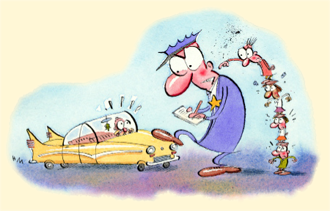The Parking Riot of '64
 It happened on a fine April weekend in 1964, and all because the Village of Gambier had decided to get tough on crime—that is, on traffic and parking violations. In addition to setting a new speed limit and putting in a bunch of new stop signs, the village hired Charles Imel as "marshal." Imel, who had come to Kenyon in 1938 as the College's first regular swimming coach, immediately started citing students or issuing warnings for parking in fire lanes, wrong-way parking, going through stop signs, and even jaywalking.
It happened on a fine April weekend in 1964, and all because the Village of Gambier had decided to get tough on crime—that is, on traffic and parking violations. In addition to setting a new speed limit and putting in a bunch of new stop signs, the village hired Charles Imel as "marshal." Imel, who had come to Kenyon in 1938 as the College's first regular swimming coach, immediately started citing students or issuing warnings for parking in fire lanes, wrong-way parking, going through stop signs, and even jaywalking.
Students didn't appreciate the crackdown. "Mr. Imel takes his job too seriously," Phil Cerny '67 would tell the Mount Vernon News after the situation blew up. Identifying himself as vice president of Students to Oppose the Police State (STOP), Cerny said that the new marshal "had even warned a student for 'looking suspicious.'"
The breaking point came when Imel, on a Saturday morning, warned a student for parking in a fire lane. The student talked back and Imel reportedly arrested him and issued a $50 fine. Word spread, and the next day around three hundred students—half of the student body—flooded downtown Gambier.
They marched off to Imel's house, yanking up stop signs, which they painted with swastikas and brandished as they chanted and sang. Other signs bore the hammer-and-sickle; one proclaimed, "Down with Police State!" Newspaper reports (an Associated Press story was picked up by papers across Ohio) said that three state highway patrol cars were summoned to the scene. At one point, students sat in front of a police car to prevent it from taking away two students.
"The students don't think they need any discipline or constructive law and order," village Mayor Leo Wolfe huffed. "They think it is all right for other places, but not in Gambier."
No, said Provost Bruce Haywood, the students were only objecting to Imel's "lack of tact."
The mayor apparently softened. "The boys have been cooped up all winter," he said, "and Sunday was such a nice day they just wanted a chance to let off some steam."
Perhaps. But the demonstration also fits into the tradition of resisting any threat to Kenyon's carefree folkways and rustic insularity. One of the groups mentioned in the press was called the "Student Committee to Keep Gambier Bucolic," as if stop signs might lead inexorably to shopping centers.
The protesters, incidentally, observed a certain civility. At Imel's home, they refrained from walking on a freshly seeded section of the front lawn. And, at least according to one student, the vandals used watercolor paint on the stop signs, so that it could be washed off.

 Delicious
Delicious Facebook
Facebook StumbleUpon
StumbleUpon Digg
Digg reddit
reddit